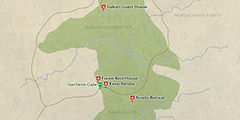- You are here:
- Home
- Countries & Parks
- Kenya Parks
- Kakamega Forest
Overview – Kakamega Forest

Philip is a renowned Africa expert and author of many guidebooks to African destinations, including the DK Eyewitness Guide to Kenya.
Philip is an expert for SafariBookings and author of the DK Eyewitness Guide to Kenya.
Philip is the author of the DK Eyewitness Guide to Kenya.
Kakamega Forest ranks among Kenya’s most rewarding bird-watching and primate-viewing hot spots. This is because, as the country’s largest surviving tropical rainforest, it forms the easternmost haunt of many species more usually associated with West Africa. The forest is a must-visit destination for keen birders, but the wondrous jungle atmosphere will also appeal greatly to walkers and other outdoor enthusiasts. Administratively, Kakamega is split between a 45km²/17mi² national reserve and a 195km²/75mi² forest reserve, which function as two separate destinations.


Pros & Cons
- Rare tropical forest habitat
- Great hiking opportunities on several forest trails
- Fantastic birding with some 410 species, including many not found elsewhere in Kenya
- Forest wildlife also includes a wealth of primates and butterflies
- Off the beaten track and little visited
- Not on any tourist circuit
- Very wet climate
- Limited accommodations include one mid-range lodge in the forest reserve, as well as a campsite and self-catering cottages in the national reserve
Kakamega Forest Safari Reviews
- Expert Rating
- Wildlife
- Scenery
- Bush Vibe
- Birding
- User Rating
- Wildlife
- Scenery
- Bush Vibe
- Birding
Wildlife
Birds aside, primates are conspicuous and include black-and-white colobus, red-tailed monkey, blue monkey and olive baboon. The rare de Brazza’s monkey is confined to the Kisere sector of the national reserve. Nocturnal primates include potto and at least two species of bush baby. Other mammals are generally difficult to spot but include bushbuck, blue duiker, black-fronted duiker and various squirrels and small carnivores. More than 400 butterfly species have been recorded.
Scenery
Kakamega Forest harbors a rich tropical environment with an immense biodiversity. Despite the heavy logging of the 1970s, there are still large tracts of ancient hardwood, such as Elgon teak, in the forest. Other flora to look out for includes a wide variety of ferns, orchids and flame lilies. Several beautiful streams run through the forest interior.
Activities
Guided and self-guided bird and nature walks are available in both the forest reserve and the national reserve. The knowledgeable local guides are superb at identifying birds and their calls. If you want to explore by car or walk unguided, the national reserve is the better option because of its well-marked network of trails and motorable tracks. To look for de Brazza’s monkey, organize an early morning or late afternoon guided walk in Kisere Forest, an annex of the national reserve situated about 5km/3mi from the entrance gate.
Weather & Climate
Kakamega Forest has a climate typical of tropical areas. Temperatures don’t rise or fall much throughout the year, and hot days are followed by cool nights. The area experiences a long Wet season (March to November), with most of the rain being dumped in April and May. It’s less damp during the comparatively brief drier season (December to February), but it can still rain a lot in these months.
Best Time To Visit
The best time to visit Kakamega is during the periods when it rains less, from December to February and June to July. It’s breeding season for the local birds around the middle of the year, and a lot of color is added by emerging butterflies in August and September. Hikes are a lot more enjoyable in the driest months, from December to February.
Want To Visit Kakamega Forest?
Kakamega Forest Safari Reviews
- Expert Rating
- Wildlife
- Scenery
- Bush Vibe
- Birding
- User Rating
- Wildlife
- Scenery
- Bush Vibe
- Birding
Most Helpful Expert Review

Lizzie is a reputed guidebook writer and author of the Footprint guides to South Africa, Namibia, Kenya, Tanzania, Uganda and Zimbabwe.
A Meander Through Spectacular Equatorial Rainforest
Kakamega is one of the last remaining (and fast diminishing) tropical rainforests of East Africa. By walking the narrow winding paths, I always find it such an extraordinarily beautiful and tranquil place. It’s characterised by tangled...
Latest User Review
 KR
KR
we saw incredible monkey with white hair on their back so pretty, Kakamega people are amazing. food was delicious .there are so many birds and the trail is wonderful.


 Kenya Parks
Kenya Parks

